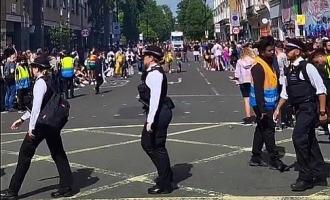Adam Yamey's Blog: YAMEY, page 41
August 30, 2024
Portraying travels around the world in colourful Japanese woodblock prints
THE DULWICH PICTURE Gallery is the oldest building in Britain designed specifically to display art works. It was designed by the architect Sir John Soane (1753-1837) and opened to the public in 1817. Completed long before the advent of electric lighting, the rooms of the gallery were illuminated by daylight that entered them from windows on the roof. Nowadays, it is illuminated by modern lighting. It would be interesting to see how it looks when it is lit solely by daylight. The institution houses a magnificent collection of works by famous ‘old masters’ and puts on temporary exhibitions, one of which is on until November 2024. The current show is dedicated to colourful woodblock prints created by three generations of a Japanese family: the Yoshida dynasty.
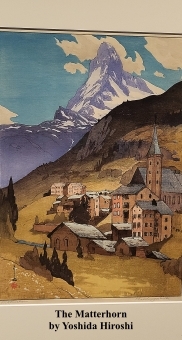
Yoshida Hiroshi (1876-1950) was married to Yoshida Fujio (1887–1987). They were both printmakers. Their sons, Yoshida Tōshi (1911–1995) and Yoshida Hodaka (1926–1995), also made prints, as did Hodaka’s wife Yoshida Chizuko (1924–2017). Chizuko and Hodaka’s daughter, Yoshida Ayomi (b. 1958), continues the family’s tradition of printmaking. She has created a site-specific installation (based on cherry blossom trees) for the exhibition. Examples of all these artists’ fine works, which range from figurative to abstraction, are displayed in the exhibition. Each exhibit is a feast for the eyes.
For me, the highlight of the show are the prints by Yoshida Hiroshi. Each one is exquisitely executed and brilliantly composed. Several of his prints on display depict scenes in Japan, ranging from a view of Mount Fuji to the interior of a shop. Hiroshi and his wife also travelled extensively: through Africa, America, Asia, and Europe. When in London in 1901, Hiroshi paid a visit to the Dulwich Picture Gallery. His signature is on a page of the Gallery’s visitors book, which is shown in the exhibition. I was particularly fascinated by the prints he made after seeing sights in the USA, Canada, Switzerland, Italy, Greece, and Egypt. The exhibition includes two beautiful depictions of the Taj Mahal in Agra (India).
Although the rest of the exhibition was fascinating, I was intrigued to see famous tourist sights so beautifully depicted by a traveller from the Far East – a man with great powers of observation and immense artistic talent.
The woodblock prints on the display are without doubt masterly creations. A short video described how they were created. The artist draws the scene to be depicted. A wood carver carefully transfers this image by carving it in reverse on a wooden block. Then a coloured ink is applied to selected parts of the block. Paper is placed on top, pressed down, and a print is created. The process is then repeated using another colour on different or the same parts of the block. This adds the second colour to the print. This process can be repeated carefully well over 30 times (up to 100 in some cases) until the desired coloured image is completed. At each stage the paper must be accurately positioned on the inked block to ensure it is placed in exactly the same place as on all the previous ink applications. The artist supervises the carver and the printer throughout the production. The process must require supreme concentration and dedication, but the end justifies the means.
One might wonder why bother with such a complex and labour-intensive process, when a scene could more easily be depicted using a brush and paints or pen and inks. I cannot answer this, but will say that the results in the hands of the Yoshida family are remarkably and delightfully distinct from pictures created by other means. If you can visit the Dulwich Picture Gallery to see the Yoshida show, then do not miss it.
August 29, 2024
A celebration of a science fiction television show at London’s Royal Albert Hall
BETWEEN SEPTEMBER AND DECEMBER 1963, I was living with my parents in a rented flat in southern Chicago because my father had been invited to work at the University of Chicago as a visiting academic for three months. I was eleven years old. On the 23rd of November, President John F Kenedy was assassinated – an event which moved me greatly at the time. Unknown to me then, there was another event that occurred in the UK on that fateful day. It was the broadcast of the first episode of BBC’s science fiction programme, “Dr Who”, which was aimed at entertaining children. Because of the assassination and power outages in Britain, the first episode was repeated a week later immediately before the second episode.
A few days later, I received an airletter from my friend Nicholas Gilks, who lived, as we did, in north London’s Hampstead Garden Suburb. His family had a television, but ours did not. So, I used to visit his home to watch children’s television (BBC) programmes that began at around 5 pm. Nick’s letter contained exciting news about the wonderful new programme, “Dr Who”, which had just begun to be broadcast. He wrote that he could not wait for me to get back to London so that we could watch it together. On my return, I saw my first episode of “Dr Who” and was both amazed by it and afraid of it. It was in black and white. Colour television had not yet arrived in the UK.
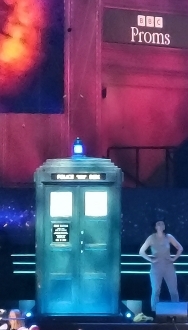
Just in case you are unfamiliar with “Dr Who”, here are a few basics. First, Dr Who is a time traveller. The first Dr Who was played by Richard Hartnell (1908-1975). The Doctor travels through space and time in an old-fashioned police box, called the ‘Tardis’. From the outside, the Tardis looks too small to hold more than one person, but on entering it, it seems very spacious. There was plenty of room for Dr Who and his two or three assistants to move around the space-age equipment within the Tardis. As Dr Who travels forwards and backwards in time, he and his companions encounter many sinister opponents, including the Daleks. These robotic objects which spoke English with a sinister accent appeared in many episodes. They were armed with weapons that could exterminate a variety of beings – human and otherwise.
“Dr Who” was screened at about 5pm. In winter and early spring, darkness had fallen by the time the programme ended. I would walk home after seeing the show, but it was so frightening that I felt scared to walk the short distance alone. So, very kindly, Nick’s father used to accompany me most of the way. When I look back on the early “Dr Who” shows today, I cannot believe that they affected me so much. In 1963 and the few years following it, what was being produced by the BBC without the benefit of sophisticated computers and digitally produced special effects was truly remarkable. And to my then young mind, it was oddly realistic even though I knew it was only a television show.
It was with some interest that today (the 26th of August 2024) we went to the Royal Albert Hall to attend the dress rehearsal of a BBC Promenade Concert dedicated to the music that has been played in “Dr Who” during the decades since I first watched it. Our daughter was performing in it as a member of the London Philharmonic Choir, which was accompanied by various soloists, and the BBC National Orchestra of Wales. As the musicians and singers performed excellently, large screens displayed excerpts from current and recent episodes of “Dr Who”. While the external appearance of the Tardis looked the same as it did in 1963, its interior has changed dramatically. It looks far more sophisticated than it did in 1963. And the excerpts demonstrated that full use is made of up-to-date computerised cinematographic technology. Although the scenes we watched did not frighten me, I thought that they would cause the children who watch it (and enjoy it) today to have nightmares. Also, there seemed to be far more romance in the excerpts than there was back in the early 1960s. My guess is, having seen a few elderly “Dr Who” enthusiasts in the audience at the Royal Albert Hall, that many who began watching the programme as children have never stopped watching it despite the passage of time since their childhood.
Sadly, my friendship with Nick diminished significantly when I was about 14. Since then, I have never seen an episode of “Dr Who”. And more tragically, a few years ago, I learned that Nick had died. Watching the dress rehearsal today and seeing a Dalek on the stage brought back memories of sitting with Nick and his brother in front of their television in their home in Hampstead Garden Suburb.
August 28, 2024
They must be expecting riot and insurrection at Amazon Fresh during the carnival
DURING THE NOTTING Hill Carnival, always held during the last weekend of August, some homes, shops, and other businesses in the area where it is held or along the routes leading to it, take precautions to prevent their properties being damaged by over exuberant (i.e., drunk, drugged, or violent) revellers. Usually, the preventative measure taken is the erection of wooden boarding, which is usually soon covered with colourful graffiti.
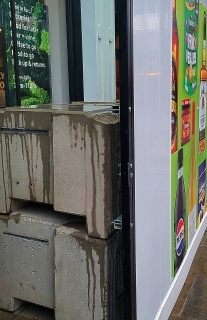
The recently opened Amazon Fresh supermarket in Notting Hill Gate has taken things much further. Not only have they put up wooden boarding (upmarket quality compared with what other businesses use), but behind it they have placed huge concrete blocks such as are usually used to make temporary barriers to protect workers from being hit by fast moving traffic while they are doing repairs on busy motorways. Furthermore, these heavy blocks have been encased in sturdy metal cages. And to prevent things from being lobbed over the top of this recreation of the Berlin Wall, netting has been placed. The weak points in this anti-insurrection barrier are gaps in it for the entrance and exit. No doubt, tough security guards will be stationed at these vulnerable positions, but would they be prepared to risk injury and the wrath of a mob simply to save the paltry selection (compared with other nearby shops) of wares sold in the shop? Finally, I wonder whether the cost of the precautions taken will be outweighed by the profits that this now unwelcoming-looking, fortress of a shop might hope to make.
August 26, 2024
At the Notting Hill Carnival
Ceilings with perforations in the home of William Morris
THE RED HOUSE in south-east London’s Bexley Heath was the only residence that William Morris (1834-1896) owned, rather than rented. The architect Philip Webb (1831-1915) designed it in a style that resembled that of the Arts and Crafts Movement, which only became prevalent in the last quarter of the 19th century. It was completed in 1860, before Morris began his now famous decorative arts company (in 1861). The house is now maintained by the National Trust, which organises guided tours though its interior. The visitor gets to see art and furniture created by Morris, his wife Jane, Edward Burne-Jones, Dante Gabriel Rossetti, and others associated with the Pre-Raphaelite Movement.
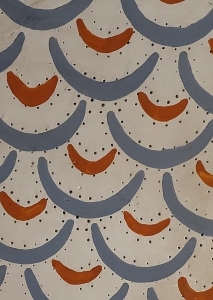
Amongst the many interesting things that the guide pointed out, one feature particularly intrigued me. That is, many of the ceilings in the house can be seen to have numerous tiny holes or perforations. If you look closely, these holes are not random, but are arranged in patterns. These patterns vary from room to room. In the large entrance hallway, which contains a couple of door panels with paintings by Morris, the ceiling is now painted white, but the perforations are arranged in a discernible pattern.
Other ceilings not only have these perforations, but are also covered with colourful hand-painted patterns. Apparently, these were painted by friends of William and Jane Morris. They used to be invited as house guests, fed, and lodged, and then expected to climb on ladders to paint patterns on the ceilings. If you look at these patterned ceilings carefully, you will notice that the painted shapes correspond to the patterns of tiny holes that perforate the ceiling panels. This is no accidental coincidence. Before the ceiling panels were installed, the perforations were made using pieces of wood in which nails had been arranged to create the pattern required for a particular ceiling. The panels were then pressed with these beds of nails to produce the desired pattern on the panels. The perforations helped the painters to create the designs that Morris had chosen for them. Although at first sight, the ceilings look as if the patterns were mass produced, careful examination reveals that the hand painted elements of each design are not precisely identical. The painters probably tried to reproduce the elements of the designs accurately, but being hand-painted rather than mechanically reproduced, tiny differences can be discerned. This is what Morris wanted: his ideal was old-fashioned craftsmanship rather than industrial mass-production.
While showing us the ceiling above the stairwell, our guide pointed out something that Morris might not have wanted. Hidden behind a beam, and quite difficult to see, there is what we now call a ‘smiley face’ instead of an element of the pattern seen on the rest of the ceiling. It might possibly have been put there by one of his unpaid friends, who was getting bored.
The Red House, which is now embedded in the aesthetically unexciting suburban sprawl of south-east London, was once in open countryside. It is well worth visiting this place, which is one of the earliest examples of what was later to become known as the Arts and Crafts style, but you do need to book your tour in advance.
August 25, 2024
Architecture in London and an ancestral place in Bavaria
FACING THE CHINESE embassy in London’s Portland Place, there is an imposing Art Deco edifice standing on a corner plot. It is the home of the Royal Institute of British Architects (‘RIBA’). We visited the place in August 2024 to view a small exhibition called “Raise the Roof: Building for Change”. Amongst other things, it explores the role of British architects, such as Edwin Lutyens and Herbert Baker, in enforcing the image of British imperialism during the 1930s in South Africa and India. After viewing this, we wandered around the RIBA building, which, as was explained in the exhibition, contains materials collected from the Empire as well as images depicting the arrogantly supposed superiority of the British colonisers over the colonised.
The building contains various informative panels, which explain aspects of its history. It was constructed between 1932 and 1934. The architect George Grey Wornum (1888-1957), who was born in London, designed the RIBA building.
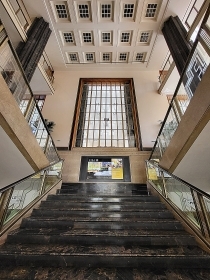
In one of the meeting halls, there is an elegant carved wooden screen, The Dominion Screen, which was carved in Quebec pine and designed by the artist Denis Dunlop (1892-1959). It contains vignettes of life in five former British possessions (only 4 of which were Dominions): Australia, South Africa, India, Canada, and New Zealand. It was paid for by William Lewis Gerstle (1868-1947), who was born in San Francisco (USA). His daughter, Miriam (1898-1989) married George Grey Wornum in 1923. She was a designer. Seeing the name Gerstle on the information panel next to the screen rang a bell in my mind.
There was an extensive Gerstle family living in the Bavarian town of Ichenhausen (near Günzburg) during the 19th century. I knew this because when researching my mother’s family, I took a great interest in this small town. It was where two of her ancestors were born. At least one of their relatives married a Gerstle from Ichenhausen. I wondered whether Miriam Gerstle’s family were originally from Ichenhausen.
When I got home, I did a little research on the Internet, and soon discovered that Miriam’s father, William, was the son of Lewis Gerstle, who was born in Ichenhausen in 1824. He died in San Francisco in 1892 (www.geni.com/people/Lewis-Gerstle/6000000008091395228). Like many Jewish people from Ichenhausen, he left the small town to seek his fortune elsewhere – in his case, in the USA. He arrived in California in 1850. During this period, many other members of his family migrated to the USA (see: www.angelfire.com/ab7/yamey/ICH.html). Many members of my mother’s family (descendants of Jakob Seligmann [1775-1843] and Moses Wimpfheimer [born 1784] of Ichenhausen) did the same thing; they went to larger German cities, such as Augsburg, to the USA, to France, and to South Africa, where my mother was born.
It turns out that Miriam Wornum is my fourth cousin twice removed!
I am pleased that after so many years of having passed the RIBA building, we finally got to see its interior, which, incidentally, is open to the public. It is a fine example of the architecture that was fashionable in the 1930s. What I had not expected was to discover that its architect was married to a lady whose ancestors were born in the same small German town as those of my mother.
August 24, 2024
Paintings and the Olympic Games in Paris in Cambridge
MY INTEREST IN the Olympic Games is limited, but that did not stop me from visiting the Fitzwilliam Museum in Cambridge, where an exhibition is being held to celebrate the 1924 Olympic Games, which were held in Paris. The exhibition, “Paris 1924: Sport, Art, and the Body”, is on until the 3rd of November 2024. Paris was, and still is, an appropriate place to hold the Olympic Games, because the man who revived this ancient Greek festival of sport, Pierre de Coubertin (1863–1937), was born in that city. The exhibition is well laid-out. Naturally, it contains many items of interest to enthusiasts of sport and the Olympic Games. Most of these are relevant to the 1924 Paris event, which was held only 10 years after the outbreak of WW1. The exhibits which interested me most were some of the paintings.
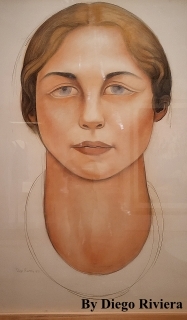
The Paris Olympics of 1924 took place during an exciting era of artistic experimentation and development. Most of the paintings in the exhibition provide evidence of that exciting period of twentieth century art. There is a painting of a gymnast by the German artist George Grosz (1893-1959), which was painted in about 1922. Works by the Italian Futurists Gino Severini (1883-1966), Enzo Benedetti (1905-1993), and Umberto Boccioni (1882-1916), figure in the exhibition. There is also a painting by Jack Butler Yeats (1871-1957), who was a brother of the famous poet William Butler Yeats. An interesting almost Cubist painting of a tennis player caught my eye. It was created in 1917 by an artist I had not heard of: André Lhote (1885-1962). A modernistic portrayal of a female runner by Willi Baumeister (1889-1955) fitted in well with the theme of the exhibition.
The paintings and sculptures chosen for the show were what made the exhibition enjoyable for me. One painting amongst them was for me the greatest surprise. It is a huge portrait depicting the face of the tennis player Mrs Helen Wills Moody (1905-1998), created in pastels in 1930. She had won two gold medals in the Olympics of 1924. I do not know why, but it was with great surprise that I saw that the artist was the Mexican Diego Riviera (1886-1957). Although the portrait is large, I had always associated Riviera with huge murals, rather than portraits and smaller paintings, of which, I have recently discovered, he created many.
I am pleased that I have seen the exhibition at the Fitzwilliam not because it has increased my interest in the Olympic Games, but because it included some fine paintings, which I had not seen before.
August 23, 2024
Anticipation
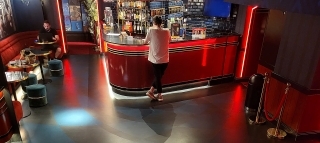
At the garden cinema in central London
At the red bar
She stands waiting quite restfully
The movie starts soon
August 22, 2024
Discovering the versatility and creativity of an artist born in Lancashire
UNTIL AUGUST 2024 when I visited Salford, I believed that there was little that excited me about the work of the artist Laurence Stephen Lowry (1887-1976). My first impression of this artist was back in the 1970s and ‘80s, when reproductions (posters) of his paintings of industrial landscapes crowded with stick-like depictions of people were popular items in print shops of the Athena chain. I liked the pictures, but there seemed to be little variety amongst the paintings that were reproduced for sale.
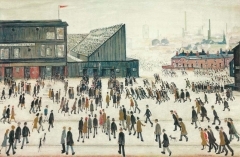
My appreciation of Lowry’s art was not improved after seeing a special exhibition of his paintings held at Tate Britain in 2013. The paintings were badly displayed. There were too many of them crowded on to the walls of the galleries. They were so densely packed into the gallery that they were difficult to examine carefully. As far as I can remember, there was little difference between the subject matter depicted in the paintings. Most of them were of the kind that I had seen reproduced in the Athena shops. I came away from the exhibition neither being impressed by it nor having gained more admiration for Lowry.
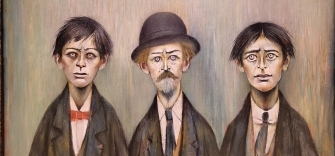
So, in August 2024 when we headed for The Lowry, a modernistic cultural centre at Salford Quays in Greater Manchester, which contains a collection of artworks by Lowry, my enthusiasm was somewhat dampened. The Lowry itself is a successfully adventurous example of modern architecture, which is well worth seeing. It contains a gallery devoted to the works of LS Lowry. Our visit to this gallery, which contains about 400 of his artworks, was, as the saying goes, ‘mind-blowing’. First of all, in comparison with the 2013 exhibition at the Tate, the works of art are extremely well displayed. Secondly, and more importantly, what we saw completely changed my mind about Lowry’s works.
Although there were several of Lowry’s works in the style favoured by customers of Athena’s outlets, these wonderful pictures were outnumbered by other images which demonstrate Lowry’s versatility as an artist. Lowry painted many faces and portraits, all of which convey the personalities of the people portrayed and the artist’s sometimes quirky or humorous perceptions. There are numerous images – both sketches and paintings – of ships. There are evocative landscapes devoid of people. Most surprising to me, are his paintings of seascapes, which are so brilliant that they put Lowry alongside Turner in his ability to capture the sea on canvas. Apart from paintings, there are numerous sketches and ‘doodles’ on display, each one of which demonstrates Lowry’s skill as a draughtsman.
The immense variety of what is on display in the gallery in The Lowry demonstrates the amazing diversity of LS Lowry’s depictions of life in Lancashire and elsewhere. The exhibition at Salford Quays opened my eyes to his brilliance, and now I realise how wrong I was when I came to a judgement of his talents before having discovered how wide a range of art he created so skilfully.
August 21, 2024
A metaphor for studying at the University of Cambridge ?
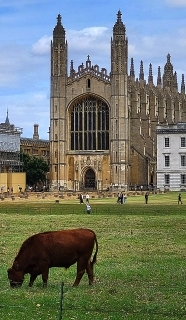
This photograph shows a cow grazing in a meadow in Cambridge (UK). Behind the animal, you can see the world famous perpendicular gothic chapel of Kings College – part of the University of Cambridge.
I posted this picture on Facebook. A few hours later, one of my friends added the witty comment:
“In one end and out the other…“

